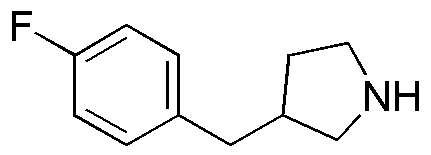3-(4-Fluorobenzyl)pyrrolidine is widely utilized in research focused on:
- Pharmaceutical Development: This compound serves as a key intermediate in synthesizing various pharmaceuticals, particularly in the development of drugs targeting neurological disorders.
- Neurotransmitter Research: It is used in studies related to neurotransmitter systems, helping researchers understand the mechanisms of action for potential treatments of mental health conditions.
- Organic Synthesis: The compound is valuable in organic chemistry for creating complex molecules, offering a versatile building block for chemists in both academic and industrial settings.
- Material Science: It finds applications in the development of new materials, particularly in creating polymers with enhanced properties for various industrial applications.
- Biochemical Assays: This chemical is employed in biochemical assays to evaluate the efficacy of new compounds, aiding in the screening process for drug discovery.
General Information
Properties
Safety and Regulations
Applications
3-(4-Fluorobenzyl)pyrrolidine is widely utilized in research focused on:
- Pharmaceutical Development: This compound serves as a key intermediate in synthesizing various pharmaceuticals, particularly in the development of drugs targeting neurological disorders.
- Neurotransmitter Research: It is used in studies related to neurotransmitter systems, helping researchers understand the mechanisms of action for potential treatments of mental health conditions.
- Organic Synthesis: The compound is valuable in organic chemistry for creating complex molecules, offering a versatile building block for chemists in both academic and industrial settings.
- Material Science: It finds applications in the development of new materials, particularly in creating polymers with enhanced properties for various industrial applications.
- Biochemical Assays: This chemical is employed in biochemical assays to evaluate the efficacy of new compounds, aiding in the screening process for drug discovery.
Documents
Safety Data Sheets (SDS)
The SDS provides comprehensive safety information on handling, storage, and disposal of the product.
Product Specification (PS)
The PS provides a comprehensive breakdown of the product’s properties, including chemical composition, physical state, purity, and storage requirements. It also details acceptable quality ranges and the product's intended applications.
Certificates of Analysis (COA)
Search for Certificates of Analysis (COA) by entering the products Lot Number. Lot and Batch Numbers can be found on a product’s label following the words ‘Lot’ or ‘Batch’.
*Catalog Number
*Lot Number
Certificates Of Origin (COO)
This COO confirms the country where the product was manufactured, and also details the materials and components used in it and whether it is derived from natural, synthetic, or other specific sources. This certificate may be required for customs, trade, and regulatory compliance.
*Catalog Number
*Lot Number
Safety Data Sheets (SDS)
The SDS provides comprehensive safety information on handling, storage, and disposal of the product.
DownloadProduct Specification (PS)
The PS provides a comprehensive breakdown of the product’s properties, including chemical composition, physical state, purity, and storage requirements. It also details acceptable quality ranges and the product's intended applications.
DownloadCertificates of Analysis (COA)
Search for Certificates of Analysis (COA) by entering the products Lot Number. Lot and Batch Numbers can be found on a product’s label following the words ‘Lot’ or ‘Batch’.
*Catalog Number
*Lot Number
Certificates Of Origin (COO)
This COO confirms the country where the product was manufactured, and also details the materials and components used in it and whether it is derived from natural, synthetic, or other specific sources. This certificate may be required for customs, trade, and regulatory compliance.

